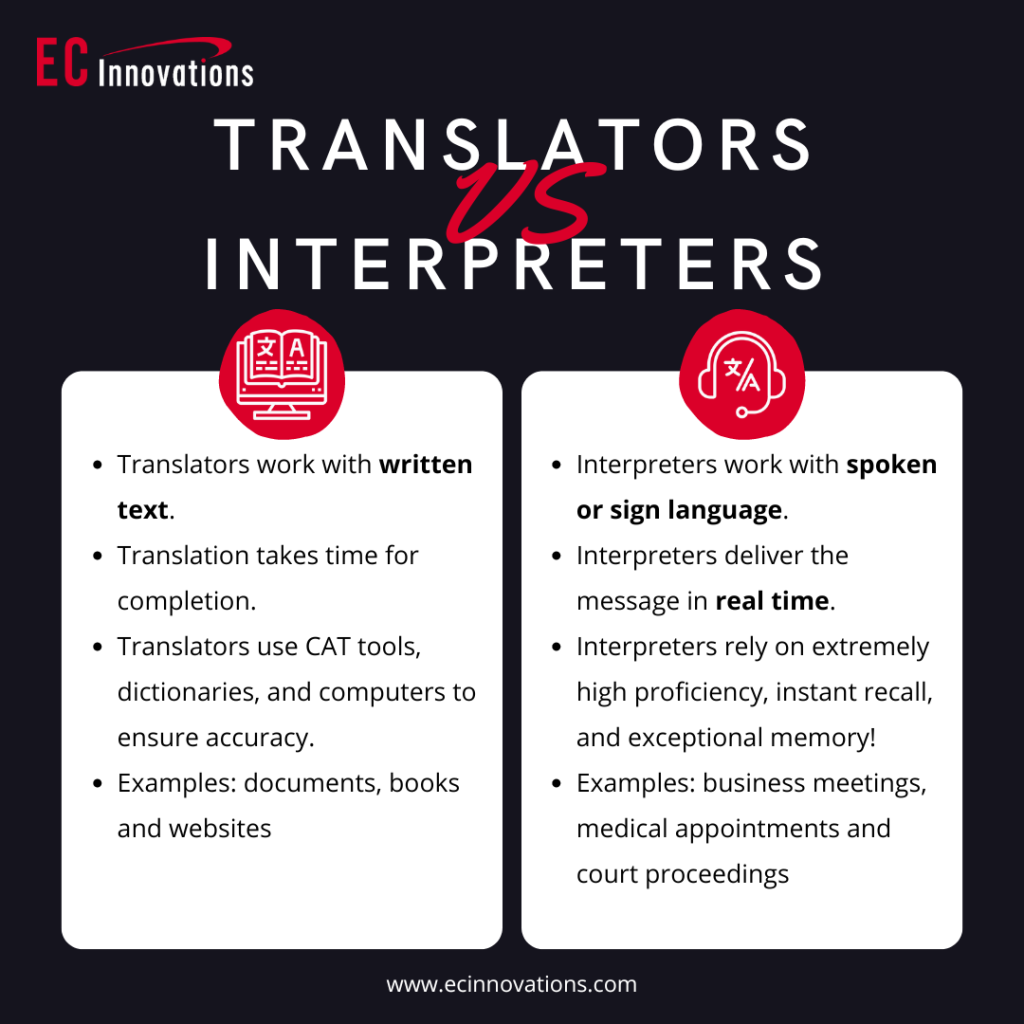Businesses and organizations increasingly rely on language services to conduct operations effectively, both domestically and internationally. Whether expanding into new markets or engaging with multicultural audiences, effective communication across cultural and linguistic divides is essential for fostering trust and building lasting relationships with consumers.
Among the myriad of language services available, interpretation and translation stand out as indispensable tools for bridging language barriers and facilitating seamless communication. While these terms are often used interchangeably, they represent distinct professional services within the language field, each requiring a unique skill set and approach.
In this guide, we’ll explore the differences between interpretation and translation, highlighting how each service works and its applications in various industries. By gaining a comprehensive understanding of these essential language services, businesses and organizations can enhance their multilingual support strategies and effectively communicate with diverse audiences, driving sustainable growth and success in today’s global marketplace.
What Is Translation?
Translation is the complex process of rendering written or spoken content from its original language into another language while preserving its meaning, tone, and intent. This multifaceted task is indispensable for facilitating communication across language barriers, allowing individuals to access information and ideas regardless of language proficiency.
Different Types of Translation
Translation encompasses a wide range of specialized fields, each requiring unique skills and expertise to ensure accuracy and clarity:
Literary Translation: This involves translating literary works such as novels, poems, plays, and short stories. It requires not only language skills but also a deep understanding of cultural nuances, literary devices, and the author’s style.
Technical Translation: Technical translation deals with the translation of technical documents such as user manuals, engineering specifications, scientific papers, and technical reports. Translators in this field must have expertise in both the source and target languages, as well as a thorough understanding of the subject matter.
Medical Translation: Medical translation involves translating documents related to healthcare, medicine, pharmaceuticals, and medical devices. Accuracy is crucial in medical translation, as mistranslations can have serious consequences. Translators in this field often have a background in medicine or healthcare.
Legal Translation: Legal translation deals with translating legal documents such as contracts, court judgments, statutes, and certificates. Legal translators must have a strong understanding of legal terminology and concepts in both the source and target languages, as well as an understanding of the legal systems involved.
Financial Translation: Financial translation involves translating documents related to finance and economics, such as annual reports, financial statements, investment reports, and banking documents. Translators in this field must be familiar with financial terminology and accounting principles in both languages.
Audiovisual Translation: Audiovisual translation encompasses various forms of translation for audiovisual media, including subtitling, dubbing, voice-over, and transcription. It involves not only translating dialogue but also adapting cultural references, idiomatic expressions, and humor to suit the target audience.
What Is Interpretation?
Interpretation, also known as “oral translation,” is the dynamic process of converting spoken or sign language from one language to another in real-time. Unlike translation, which deals with written text, interpretation focuses on the spoken word, allowing individuals to communicate effectively across language barriers in various settings.
Different Types of Interpretation
Interpretation involves several specialized techniques, each suited to different contexts and communication needs:
Simultaneous Interpretation: Simultaneous interpreters translate spoken content into the target language in real-time, often in settings such as conferences, large meetings, or international events. Equipped with headphones and microphones, interpreters listen to the speaker’s message and convey it simultaneously to the audience, ensuring seamless communication without interruptions.
Consecutive Interpretation: Consecutive interpreters listen to the speaker’s message in the source language and then render it into the target language after the speaker has finished speaking. This method is commonly used in smaller meetings, presentations, or interviews, allowing for a more deliberate and structured exchange of information.
Over-the-Phone Interpreting (OPI): Over-the-phone interpreting enables real-time interpretation services via telephone, connecting individuals who speak different languages with qualified interpreters. OPI is commonly utilized in situations where in-person interpretation is not feasible or practical, offering convenient access to language support for various purposes, including medical appointments, customer service inquiries, and legal consultations.
Video Remote Interpreting (VRI): Video remote interpreting leverages video conferencing technology to facilitate real-time interpretation services between individuals located in different geographical locations. VRI offers visual and auditory cues, enhancing communication clarity and enabling interpreters to convey messages accurately. This method is particularly valuable in situations where visual cues and non-verbal communication play a crucial role, such as medical consultations, legal proceedings, or business negotiations conducted remotely.
5 Key Differences Between Translation and Interpretation
1. Format
Translation primarily involves the conversion of written language from one language to another, and includes texts, documents, and written materials. Interpretation, on the other hand, deals with spoken or sign language, enabling immediate, real-time communication between individuals.
2. Delivery Time
One of the fundamental distinctions between translation and interpretation is the time required to complete the task. Translation typically involves a longer timeframe, allowing translators to carefully craft and refine their translations over days or weeks. In contrast, interpretation demands immediate responsiveness, with interpreters conveying messages instantly during conversations, meetings, or events.
3. Translation Accuracy
While both translation and interpretation require a high level of accuracy, the nature of real-time interpretation allows for some flexibility in conveying the message. Interpreters aim to capture the essence and meaning of the speaker’s words accurately but may adapt the message to ensure fluid communication and comprehension. In contrast, translators have the luxury of time to meticulously research, analyze, and refine their translations, striving for the utmost precision and fidelity to the original text.
4. Skills Required
Translators and interpreters possess distinct sets of skills tailored to their respective roles. Translators must excel in written communication, possessing proficiency in grammar, syntax, and vocabulary in both the source and target languages. They also require strong research and analytical skills to accurately convey complex concepts and cultural nuances in their translations.
Interpreters, on the other hand, must excel in oral communication, demonstrating fluency, clarity, and conciseness in conveying spoken messages. They must possess exceptional listening and memory skills to interpret language accurately and fluently in real-time, often in high-pressure environments. Additionally, interpreters must be adept at capturing and conveying the tone, intent, and cultural context of the speaker’s message to ensure effective communication between parties.
5. Tools and Techniques
Translators and interpreters use different tools and techniques to facilitate their work. Translators often utilize Computer-Aided Translation (CAT) tools, dictionaries, and translation memory software to increase the efficiency and consistency of their translations. In contrast, interpreters rely primarily on their listening and memory skills to interpret spoken language accurately and fluently in real-time. While interpreters may use technology such as interpreting software or audio equipment in certain settings, their performance relies heavily on their linguistic proficiency and cognitive abilities.

Translation vs Interpretation: Which Service Do You Need?
In conclusion, understanding the differences between translation and interpretation is key for businesses navigating multilingual environments. By recognizing the unique roles and requirements of each service, you can make informed decisions about which solution best meets your communication goals.
Whether you need accurate translations of written documents or real-time interpretation for live events and meetings, our language services are tailored to meet your specific needs. Our team of experienced translators and interpreters is dedicated to delivering high-quality language solutions that bridge language barriers and facilitate seamless communication. Contact us today to learn more about how we can help you connect with your target audience in their native language.




